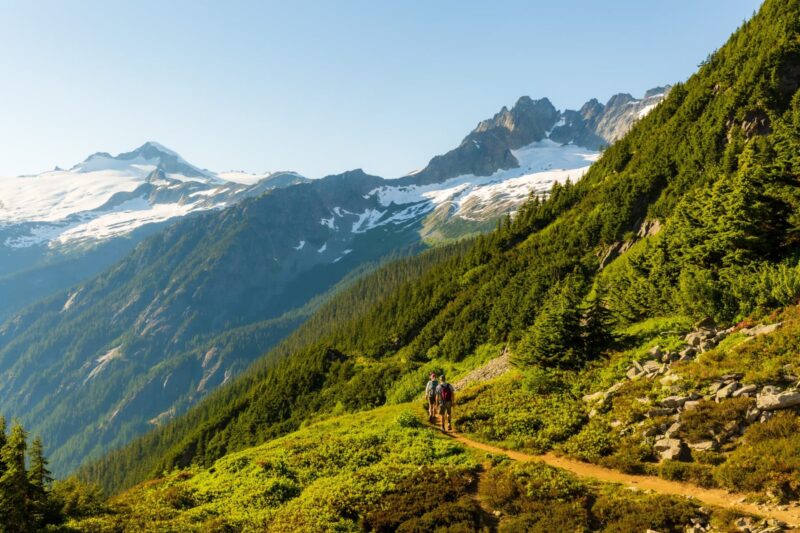Hiking with a group changes everything. It’s not just about the distance covered or the elevation gained; it’s about the rhythm of shared steps, the pauses where conversation fades into birdsong, and the stories that linger long after boots come off.
North America offers more terrain than a lifetime could cover, but in 2025, certain trails stand out for groups who want challenge, scenery, and camaraderie in equal measure.
The Pacific Northwest
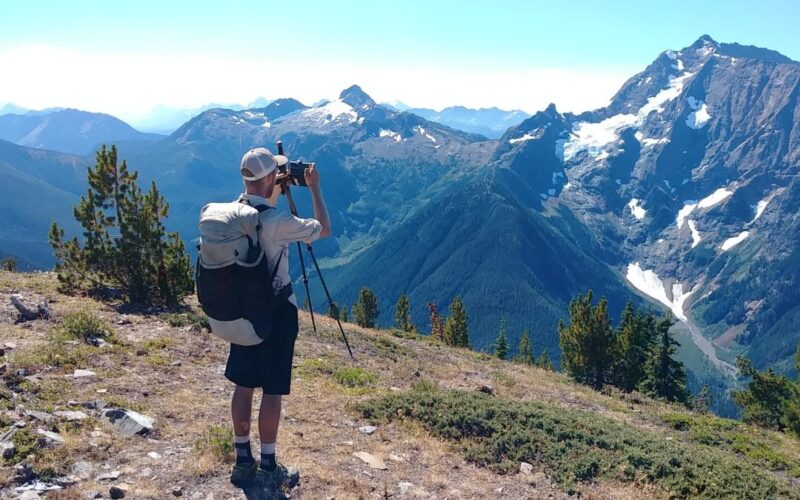
The Pacific Northwest has a kind of quiet authority when it comes to hiking. It doesn’t show off – it just is. For a hiking group, it’s heaven: lush forests, dramatic coastlines, and volcano views that make you forget you’re still on the same continent.
In the Pacific Northwest, where thick forests and steep ridgelines can cut off mobile coverage for hours, gear from poclink.com keeps hiking groups connected even when signals drop.
Mount Rainier National Park, Washington
Groups looking for high-elevation drama can’t go wrong with the trails around Mount Rainier. The Wonderland Trail encircles the volcano in 93 miles of alpine forests, subalpine meadows, and glacial rivers.
You don’t need to do all of it to feel its weight. Multi-day sections like Longmire to Sunrise or Mowich Lake to Reflection Lakes offer immersive yet manageable stretches for coordinated teams.
Quick Tips for Group Hikers
- Apply early for camping permits. Rainier’s quota system fills up quickly.
- Plan resupplies carefully – sections can stretch over 20 miles without reliable water or food stops.
- Split gear smartly among members; shared stoves and tents make a big difference in weight.
Olympic National Park, Washington
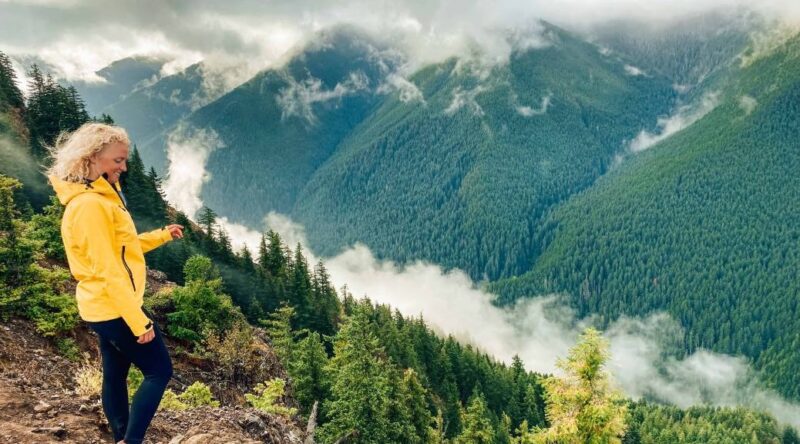
Few places balance rainforest humidity and coastal wind quite like Olympic. The Hoh Rain Forest Trail leads through moss-draped trees, while the Ozette Triangle Loop gives hiking groups a coastal route where sea stacks and tide pools become part of the rhythm.
Those who like varied landscapes will appreciate that in one park you can go from glacier-fed peaks to beaches covered in driftwood within a day’s drive.
The American Southwest
Desert hiking demands a certain patience – and respect. For groups, that means shared accountability. When the temperature hits triple digits, being part of a well-prepared team is more than just comfort; it’s survival.
Grand Canyon National Park, Arizona
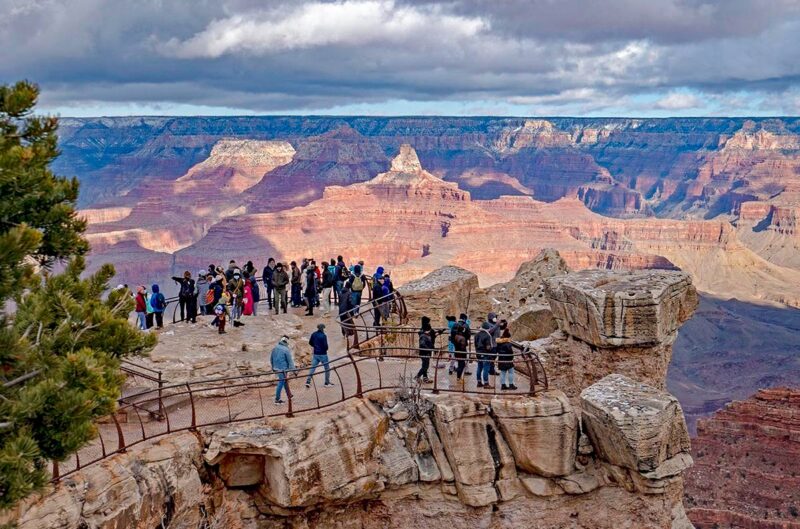
No list could skip the Grand Canyon, but few realize how well-suited it is for group expeditions. The Rim-to-Rim route is legendary, crossing 24 miles from the North Rim to the South Rim through switchbacks, oases, and geologic layers that stretch millions of years deep.
It’s not a casual stroll. Permits, training, and hydration planning are non-negotiable. But hiking as a coordinated group – supporting each other through climbs, pacing water breaks, and resting at Phantom Ranch – turns it into a collective triumph.
Best season: May to June or September to October, when temperatures are manageable.
Zion National Park, Utah
Zion rewards groups who plan ahead. The park’s permit system limits overcrowding, so once you’re in, the experience feels personal. The West Rim Trail is ideal for groups that want both challenge and solitude.
Another favorite, The Narrows, offers a totally different experience: hiking directly through the Virgin River, wading between towering canyon walls. Coordination is everything here – groups must move together, watch footing, and gauge water flow conditions daily.
Group Gear Checklist
- Trekking poles for river balance
- Dry bags for electronics
- Closed-toe shoes that grip well on wet rock
The Rockies
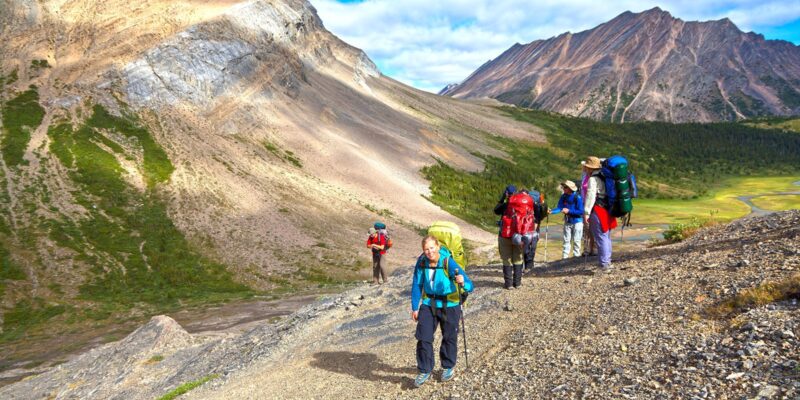
There’s something about hiking in the Rockies that humbles even the most seasoned groups. Everything feels bigger: the climbs, the views, the storms that roll in out of nowhere. But it also makes teamwork matter more than ever.
Banff and Jasper National Parks, Alberta, Canada
If your group wants to test both lungs and logistics, the Skyline Trail in Jasper and the Plain of Six Glaciers Trail in Banff deliver exactly that. The Skyline Trail stretches nearly 30 miles through alpine tundra, where most of the route stays above treeline. That means unobstructed views – and no hiding from weather.
Banff’s trails are more accessible but no less majestic. The Plain of Six Glaciers combines glaciers, tea houses, and mountain peaks in a compact package that suits groups of varied fitness levels.
Pro tip: Book group accommodations early in summer. Both parks fill up fast, especially with international tourism rebounding.
Rocky Mountain National Park, Colorado
In the lower 48, few places rival the variety within Rocky Mountain National Park. The Sky Pond Trail is a group favorite: waterfalls, alpine lakes, and just enough climbing to make you earn every view.
Groups looking for longer routes should consider the Tonahutu Creek to Flattop Mountain Loop, which rewards early risers with sunrise light bouncing off granite spires.
Because altitude can hit hard, stagger arrival days to let everyone acclimate before tackling the big routes.
The Appalachian Range
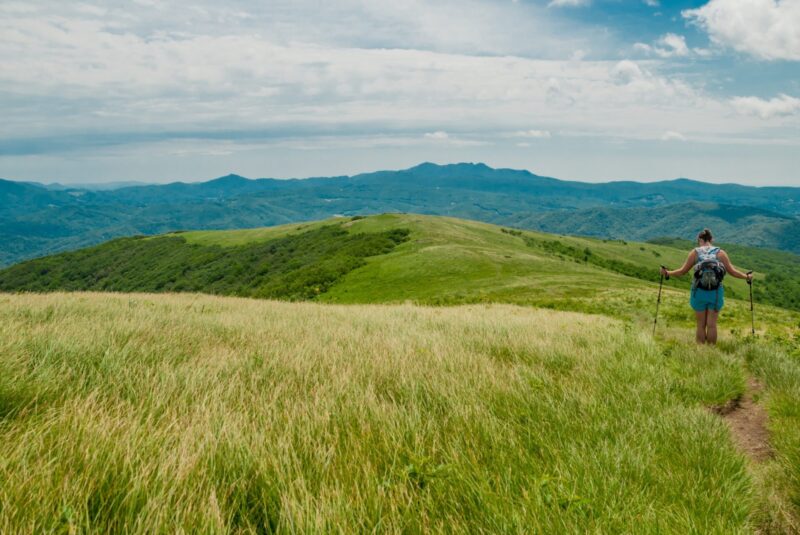
The Appalachians are softer in shape than the Rockies but harder in history. Trails here are lined with stories, from old mining paths to routes used by early settlers. For group hiking, the combination of accessibility and community spirit makes it ideal.
The Appalachian Trail (AT)
Stretching over 2,190 miles from Georgia to Maine, the AT has always been more about mindset than mileage. For groups, section hiking makes the most sense.
The Great Smoky Mountains segment between Fontana Dam and Clingmans Dome is particularly rewarding – wildflowers in spring, ridgeline views in fall, and cabins that make nightly regrouping easy.
Hiking as a team on the AT brings real advantages: shared logistics for shuttles, safety in numbers against wildlife, and the morale that carries you through endless switchbacks.
Recommended Group Sections
- McAfee Knob (Virginia): A shorter day hike with an iconic overlook.
- Franconia Ridge (New Hampshire): One of the AT’s most photogenic alpine ridges.
- 100-Mile Wilderness (Maine): For expert groups wanting solitude and challenge.
White Mountains, New Hampshire
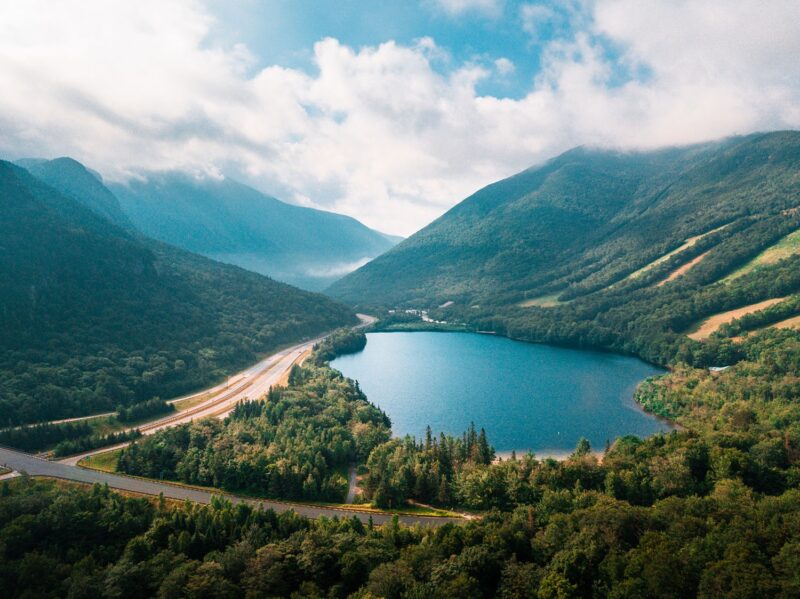
If you want steep climbs and unpredictable weather, the White Mountains will test you in ways that reward preparation.
The Presidential Traverse strings together peaks named after U.S. presidents, each rising above 4,000 feet. It’s about 20 miles long, and most groups split it over two days with a night at Lakes of the Clouds Hut.
The alpine terrain here is as demanding as it is spectacular. Even experienced hikers respect it, which makes it a perfect proving ground for cohesive groups.
The Pacific Coast
Hiking near the ocean brings a kind of rhythm that mountain ranges can’t replicate. The sea becomes a metronome for your group – steady, patient, and unpredictable.
Big Sur, California
For groups that crave ocean views without constant elevation punishment, Big Sur delivers. Trails like Pine Ridge and Ewoldsen mix redwoods, cliffs, and open coastal ridges. After long days on the trail, there’s no shortage of campsites or small lodges to regroup and share meals.
Because the region sees frequent closures from weather or landslides, always check current trail conditions before committing to routes.
West Coast Trail, British Columbia
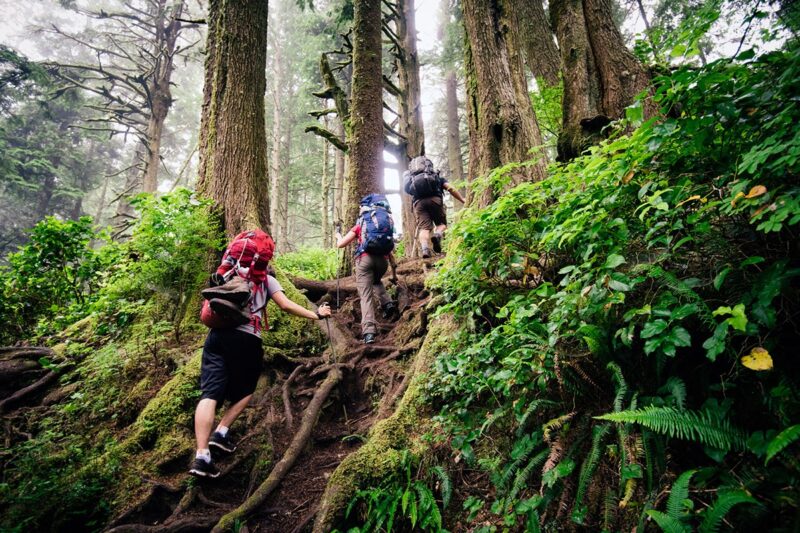
Arguably one of the continent’s finest group adventures, the West Coast Trail runs about 47 miles along Vancouver Island’s rugged shoreline. It combines ladders, river crossings, and beach hikes into a logistical puzzle that demands coordination.
Many groups plan it as a six- or seven-day expedition, balancing camp setup, tide timing, and shared cooking duties. Those who finish together often describe it as the best team-building experience they’ve ever had.
Key Logistics
- Reserve early; only 75 hikers per day are allowed.
- Expect to get wet – waterproof everything.
- Ferry crossings and ladders add to both fun and challenge.
The Midwest and Great Lakes
The Midwest gets overlooked in hiking conversations, but that’s a mistake. For groups who appreciate variety without altitude headaches, the region’s trails offer forest solitude and lakeshore beauty in equal measure.
Isle Royale National Park, Michigan
Reachable only by boat or seaplane, Isle Royale is as remote as you can get in the continental U.S. The Greenstone Ridge Trail runs about 40 miles across the island, ideal for groups wanting multi-day immersion without the crowds.
Moose sightings are common, and the island’s isolation means your group must rely entirely on itself – a rare luxury in modern hiking. Summer brings mosquitoes, so bring head nets and long sleeves.
Superior Hiking Trail, Minnesota
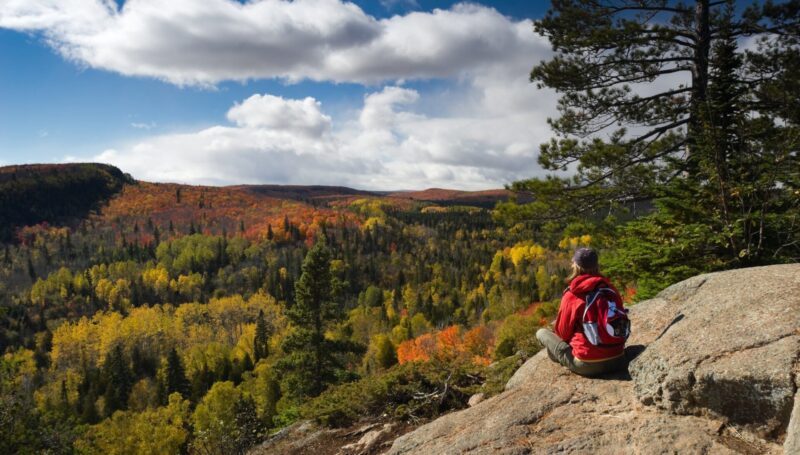
Running roughly 300 miles along Lake Superior’s north shore, this trail feels wild without being punishing. Groups can pick shorter weekend sections, often with lake overlooks, waterfalls, and easy access to resupply towns.
The Gooseberry Falls to Silver Bay stretch is particularly scenic and manageable, making it great for mixed-experience groups.
Alaska
If your group has experience and logistics support, Alaska will expand your idea of wilderness. Everything is bigger: rivers, peaks, wildlife, and distances between trailheads.
Denali National Park
Few hikes in North America feel as raw as those in Denali. There are limited marked trails, which forces groups to rely on map reading, compass work, and coordination.
The Savage Alpine Trail and Eielson Alpine Trail are manageable half-day options, while more adventurous groups can attempt backcountry zones that require permits and bear-proofing.
Safety Essentials
- Each member should carry bear spray and know how to use it.
- Satellite communication is strongly recommended.
- Plan extra buffer days – weather changes fast.
Harding Icefield Trail, Kenai Fjords National Park
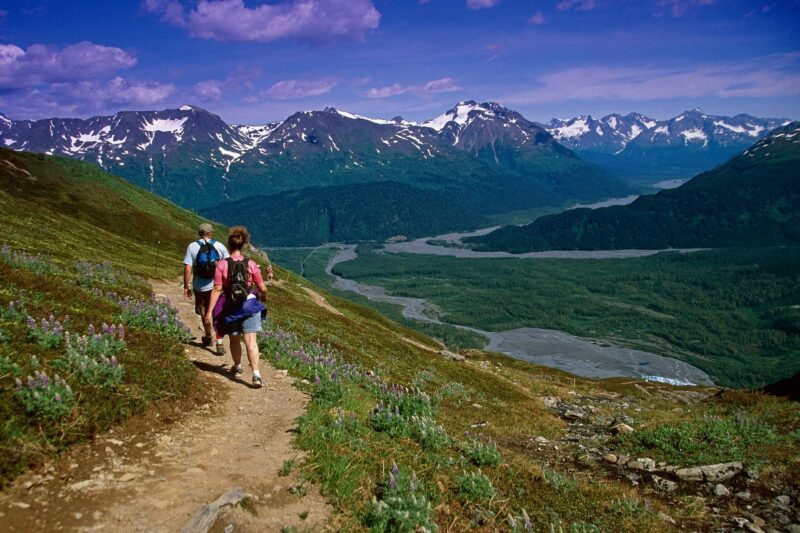
For a shorter but unforgettable group experience, the Harding Icefield Trail climbs roughly 4 miles each way to an overlook that peers across a vast sea of ice. It’s strenuous but short enough to fit into a group trip with varied abilities.
The glacier views feel prehistoric, and teamwork helps everyone reach the top safely through slippery sections and unpredictable winds.
Sample Group Trail Comparison Table
| Location | Trail | Distance | Difficulty | Ideal Group Size | Best Season |
| Mount Rainier, WA | Wonderland Trail (sections) | 93 miles | Hard | 4–6 | July–September |
| Grand Canyon, AZ | Rim-to-Rim | 24 miles | Hard | 3–8 | May–June, Sept–Oct |
| Banff, AB | Plain of Six Glaciers | 8 miles | Moderate | 4–10 | June–September |
| Appalachian Trail, TN–NC | Fontana Dam to Clingmans Dome | 30 miles | Moderate | 3–6 | April–October |
| Big Sur, CA | Pine Ridge Trail | 20 miles | Moderate | 4–8 | March–June |
| Isle Royale, MI | Greenstone Ridge | 40 miles | Moderate–Hard | 3–6 | June–August |
| Denali, AK | Savage Alpine Trail | 8 miles | Moderate | 4–6 | June–September |
Planning for Group Hiking Success
Even with the best trails, a group trip can unravel without structure. Shared preparation matters as much as shared miles.
Pre-Trip Essentials
- Gear check meetings: Assign equipment to prevent duplication and ensure coverage for cooking, shelter, and safety.
- Fitness alignment: Not everyone hikes at the same pace; plan accordingly.
- Communication: Use satellite messengers or radios in remote zones.
- Leave No Trace: Rotate responsibilities for campsite cleanup and waste management.
During the Hike
- Rotate leaders daily to distribute responsibility.
- Keep an agreed pace; faster hikers should pause at junctions.
- Check-in points matter – never assume someone’s behind you.
Group hiking isn’t just about trail selection; it’s about group cohesion. The terrain becomes a backdrop for how well people adapt, share, and move together.
Final Thoughts
A hiking group thrives on shared challenge, and North America’s wild places provide no shortage of it.
From the damp ferns of Olympic to the sandstone towers of Zion, the alpine ridges of Banff, and the solitude of Isle Royale, the continent invites you to move as one – each step different, but every destination shared.

